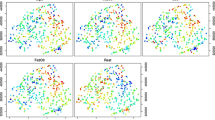Abstract
The random function is a mathematical model commonly used in the assessment of uncertainty associated with a spatially correlated attribute that has been partially sampled. There are multiple algorithms for modeling such random functions, all sharing the requirement of specifying various parameters that have critical influence on the results. The importance of finding ways to compare the methods and setting parameters to obtain results that better model uncertainty has increased as these algorithms have grown in number and complexity. Crossvalidation has been used in spatial statistics, mostly in kriging, for the analysis of mean square errors. An appeal of this approach is its ability to work with the same empirical sample available for running the algorithms. This paper goes beyond checking estimates by formulating a function sensitive to conditional bias. Under ideal conditions, such function turns into a straight line, which can be used as a reference for preparing measures of performance. Applied to kriging, deviations from the ideal line provide sensitivity to the semivariogram lacking in crossvalidation of kriging errors and are more sensitive to conditional bias than analyses of errors. In terms of stochastic simulation, in addition to finding better parameters, the deviations allow comparison of the realizations resulting from the applications of different methods. Examples show improvements of about 30% in the deviations and approximately 10% in the square root of mean square errors between reasonable starting modelling and the solutions according to the new criteria.











Similar content being viewed by others
References
Chilès JP, Delfiner P (1999) Geostatistics: modeling spatial uncertainty. Wiley-Interscience, New York
Corder GW, Foreman DI (2009) Nonparametric statistics for non-statisticians: a step-by-step approach. Wiley, Hoboken
Cressie NAC (1993) Statistics for spatial data. Wiley-Interscience, New York
Deutsch CV (1997) Direct assessment of local accuracy and precision. In: Baafi EY, Schofield NA (eds) Geostatistics Wollongong’96. Kluwer Academic Publishers, Dordrecht, pp 115–125
Deutsch CV, Journel AG (1998) GSLIB: geostatistical software library and user’s guide. Oxford University Press, New York (and one CD-ROM)
Emery X (2004) Simple and ordinary multigaussian kriging for estimating recoverable reserves. Math Geol 37(3):295–319
Emery X (2008) Statistical test for validating geostatistical simulation algorithms. Comput Geosci 34(11):1610–1620
Goovaerts P (2001) Geostatistical modelling of uncertainty in soil science. Geoderma 103(1–2):3–26
Leuangthong O, McLennan JA, Deutsch CV (2004) Minimum acceptance criteria for geostatistical realizations. Nat Resour Res 13(3):131–141
Olea RA (1996) XVAN: a computer program for the analysis of spatial estimation errors. Comput Geosci 22(4):445–448
Olea RA (1999) Geostatistics for engineers and earth scientists. Kluwer Academic Press, Norwell
Olea RA (2007) Declustering of clustered preferential sampling for global histogram and semivariogram inference. Math Geol 39(5):453–467
Olea RA, Pawlowsky-Glahn V (2009) Kolmogorov–Smirnov test for spatially correlated data. Stoch Environ Res Risk Assess 23(6):749–757
Remy N, Boucher A, Wu J (2009) Applied geostatistics with SGeMS: a user’s guide. Cambridge University Press, New York (one CD ROM)
Stephens MA (1986) Test based on EDF statistics. In: D’Agostino RB, Stephens MA (eds) Goodness-of-fit techniques. Marcel Dekker, New York, pp 97–193
Acknowledgments
Special thanks are due to Oy Leuangthong (University of Alberta), John R. Evans (US Geological Survey), and two anonymous reviewers for their reviews that contributed to improving earlier versions of the paper.
Author information
Authors and Affiliations
Corresponding author
Rights and permissions
About this article
Cite this article
Olea, R.A. Building on crossvalidation for increasing the quality of geostatistical modeling. Stoch Environ Res Risk Assess 26, 73–82 (2012). https://doi.org/10.1007/s00477-011-0496-2
Published:
Issue Date:
DOI: https://doi.org/10.1007/s00477-011-0496-2




